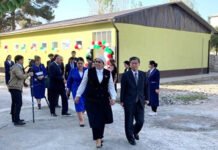The book “Ashkkhoi zeri boron” (“Tears in the rain”) is devoted to the topic of labor migration of tajik citizens to the Russian Federation and targeted to a wide range of readers.
Most of the detective stories told in the book are based on real events that the author collected during his trips in different cities of Russian Federation, when become familiar with the life of Tajik migrants.
The book covers 7 detective stories, each of which describes a specific aspects of the life of migrants.
The first detective story of the author is called “Ashkkhoi zeri boron” “Tears in the rain.” The book takes its title from this story. This name is symbolic, the purpose of which is to show the suffering of Tajik migrants in Russian Federation. This suffering was compared by the feeling like crying when it’s raining outside, when tears and raindrops are mixed, and it is not clear where the drops are and where the tears are.
The main character of the story is a Tajik lady Mavjuda, who lost her parents and brothers during the civil war and fled the country. She is accompanied by another young man named Shohsaid, who also lost his parents in the civil war. First, they flee from the war zone, reach Dushanbe with great difficulty and suffering, and then emigrate to Russia.
Being in migration, the heroes of the story also experienced many hardships, as a result, the young people got married, they had a son. Subsequently, Shokhsaid disappears in Russia, and his further fate remains unknown.
“Orzukhoi khokistarshuda” (“Dreams turned to ashes”) is also based on real story: in December 2014, skinheads committed a brutal murder of a Tajik family in the Sverdlovsk region. Abror was only 43 years old, and his wife Saida was 37 years old. The couple emigrated to earn money to buy a house in their homeland, not knowing what fate was designed for them.
They didn’t know that Russian skinheads would not even spare the six-year-old child, and she would suffer the same fate as the 9-year-old Khursheda, who was killed in St. Petersburg.
“Bozgash az on dunyo” “Return from the other world” tells the story of a migrant named Mahmadyor, who went missing for 11 years, and then returned home crippled and disabled and found out that his wife had married, and his daughter, who was very young, when he left her, now 17 years old. Upon his return, it turns out that Mahmadyor escaped from slavery, but then fell into the hands of drug dealers – countrymen and eventually ended up in prison. The main character has a very bitter story. Before his arrival, news came of his passing, and his relatives mourned him when he returned.
“Domi fireb” (“The Trap of Deception”) tells the story of teacher Komron, who says that the low salary of teachers not only makes it impossible to provide for a family, but even does not allow marriage.
The guy emigrated in order to earn money for getting married and improving his wellbeing. He borrowed money from a neighbor who worked in Russia for many years. His neighbor lends him money, helps him get married, and tricks Komron into turning himself into a living container to deliver heroin to Moscow in his stomach. Only after this incident, Komron found out that the neighbor was one of the leaders of the drug gang.
He had a very difficult life and, finally, on the advice of his wife and a layer relative, revealed the secrets of this criminal group, putting them behind bars and freeing from slavery.
“Ruzi siyohi muhoqir” (“Migrant’s Black Day”) tells the story of a migrant who accidentally meets a woman at the Dushanbe airport, who, referring to her overweight, asks him to register her bag in his name. Only in Moscow, during a search and detention at the airport, he found out that the woman was carrying a large dose of heroin, and he fell into a trap. The guy spent time in prison and returned home with amputated legs.
“Kafas” (“Cage”) is a short autobiographical story about the life and work of a man who was deported from Russia and spent two months in a temporary detention cell for foreigners. There, in detention, he sees how the prison authorities take bribes from migrants in order to expedite their deportation to their homeland.
“Dahshat dar tahkhona” – “Horror in the basement.” The main character of this story is called Dilovar. Dilovar is a 12-year-old boy who is taken by his mother to Orenburg in search of his father, along with his sister and two little brothers. A misunderstanding occurs between husband and wife, and the mother takes the children and runs away from him. She works as a janitor in Orenburg and chooses a basement for her children to sleep in. However, due to lack of funds and her husband’s infidelity, she condemned herself and her children to death in this basement. The incident happened in 2004, only Dilovar survived. He was found half-dead after 52 days.
The book also contains over 100 jokes and short memoirs directly related to the life of migrants. Upon completion, the author added information about the citizens who died in migration from 4 villages of Penjikent and the poem “Duo” (Prayer).
The author describes the pain and suffering of people which is very difficult to read if without tears. Bitter stories about unbearable life, hard work and deception, opium trade and imprisonment, falling into a trap and punishment, cruel treatment of Tajik migrants by nationalists and skinheads, and dozens of other problems are told by our compatriots in this book.
Join us on Telegram! Be aware of all news! https://t.me/sugdnewss. As well you can receive information on Facebook, Instagram and OK






